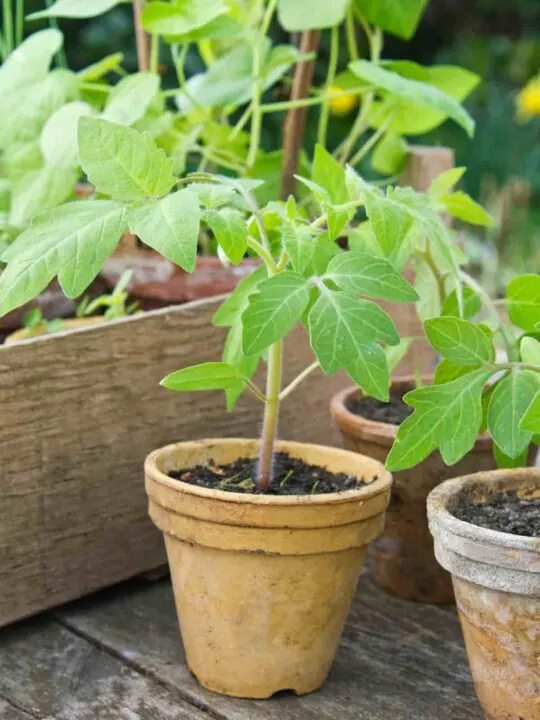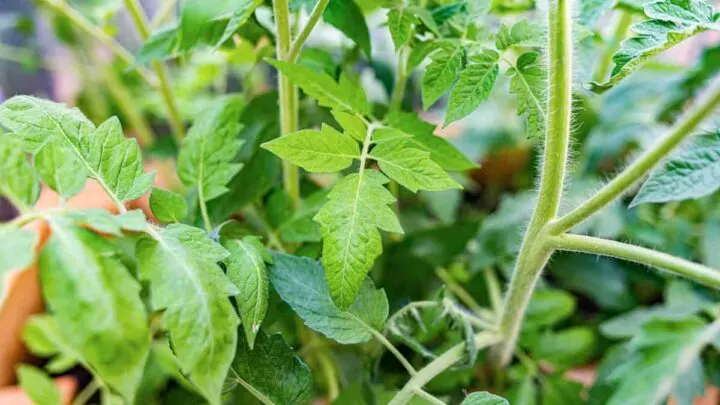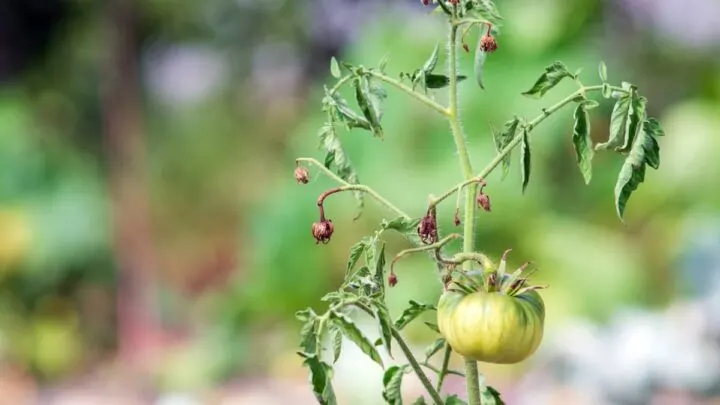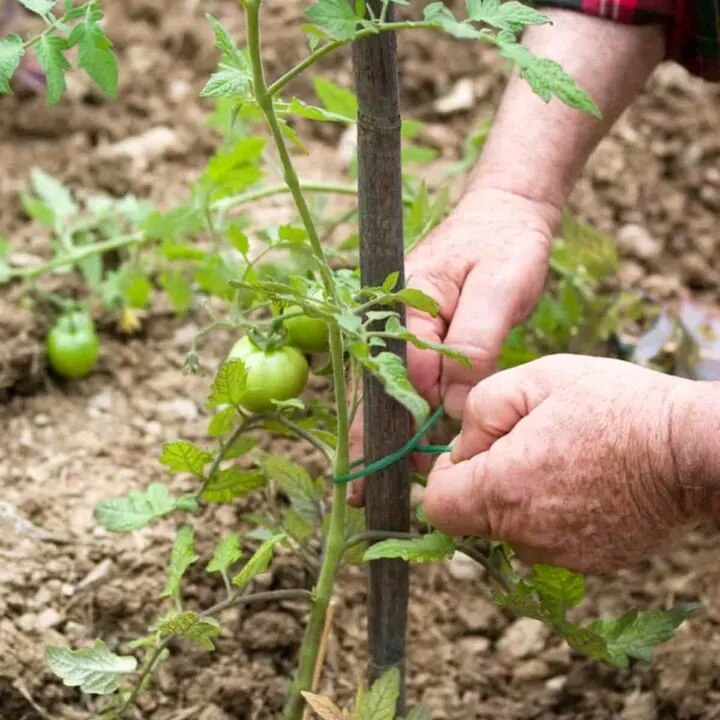There may be a time when you are forced to transplant your tomato plant after it has already been planted. Transplanting plants is a sensitive process, and it is crucial to handle the transplant correctly to avoid any adverse effects on your plants. It can be upsetting if you had a tomato plant that was growing nicely, and then the plant suddenly stopped growing after the transplant took place. It’s natural to wonder where things went wrong with the process!
Transplant shock can cause tomato plants to stop growing. The transplantation of a tomato plant often causes the plant’s development to freeze or grow stagnant, and it can take up to a month for a plant to recover from the shock of the new environment. Environmental factors like poor soil conditions, water issues, timing, etc., all cause stress on your plants.
Stress will cause a plant to stop growing. Read on to learn more about why tomato transplants can stunt growth and what you can do to prevent it from happening in your garden!

7 Reasons Tomatoes Don’t Grow After Being Transplanted
Let’s take a detailed look at all the reasons why tomato plants seem to stop growing after being transplanted.
Transplant Shock
Transplant shock can occur when plants are removed from their original container and planted in a new area. The shock of the plant’s roots being moved causes the plant to wilt and yellow, the plant’s leaves will curl, and the plant will not grow during this time.
Transplant shock can last for two weeks to a month. However, almost all plants will recover from transplant shock as long as they are cared for properly.
Not Enough Water
Like all living things, tomatoes need water to grow! Tomatoes are heavy water feeders that rely heavily on water to carry on their growing process. Not only do tomatoes require water to grow, but water also helps carry nutrients and oxygen through the roots into the rest of the plant’s system.
When a tomato plant doesn’t have enough water, it is not getting the nutrients it needs to grow; therefore, it won’t grow.
You Transplanted Into Poor Soil
Tomato plants need nutrients. They also need soil rich in nutrients and full of organic compost. This will help the plant stay happy and healthy and grow as it should.
Poor soil means that it lacks any nutrients, that it is just regular dirt. Poor soil may also be too rocky and doesn’t drain well.

Over Fertilization
On the one hand, tomato plants need lots of nutrients. However, it is also possible to over-fertilize tomato plants.
When a tomato plant is over-fertilized, the plant does not know what to do with the extra nutrients. Its sort of like the plant is being drowned in nutrients. Specifically, nitrogen is the easiest one to over-fertilize with, and you will commonly hear something called “nitrogen burn.” The leaves will turn yellow, dry out, and the plant will stop growing.
Season/Timing
Tomato plants are a little picky about the weather they are in. They are warm season, summertime plants that need the daily temperatures to be around 70-90 degrees F.
The plants don’t have the necessary temperature when the weather is below 65 or above 95. The plant goes into a sort of shock when the weather gets too cold or too hot. Symptoms of shock often include stunted growth.
Pruning
The biggest problem with over-pruning is removing much of the shade the plant requires. This would result in the plant getting too hot, or burned, which in the long run means stunted growth.
Pruning is essential for tomato plants. However, you only absolutely need to prune the bottom branches and leaves. The point of pruning is to help the plant direct energy to the branches and leaves that matter more, which would be the main branches at the top of the plant. The bottom leaves and branches will never amount to anything and are just taking up energy.

Your Tomato Has Developed A Disease
Unfortunately, tomatoes are susceptible to many diseases. Some of those diseases have many symptoms, including stunted growth.
Some diseases include tomato spotted virus, fusarium wilt, blight, and mosaic virus. With all of these diseases, there is no cure. They are viral diseases that are spread through bugs or the soil.
The only way to get rid of the disease is to rip off the plants, burn them (never put them in your compost, for risk of spreading the disease), then heat treat your soil. Rotate your crops every year to help prevent disease.
3 Ways To Help Your Tomato Plant Grow After Being Transplanted
Luckily, there are some ways you can help your plants during transplant and lessen the blow of transplant shock. Here is how.
Shading
The easiest way to help your plants along with transplant is to cover them, especially during the hottest parts of the day. You can cover them with newspaper, shade cloth, or netting. This will allow the plant to breathe, but the hot sun won’t harm the fragile seedling.
Epsom Salt
An old trick is to plant your plants with Epsom salt. The ratio is one tablespoon to 1 gallon of water; combine well. Pour a little bit into each hole before you bury your tomato seedling. Epsom salt helps trigger chlorophyll production. This means the plant can start taking in new nutrients more easily and quickly. Once the tomato seedling is taking in new nutrients, it can heal and begin to grow.
Bury Them
You’re already burying them, but knowing how to bury tomato seedlings correctly is important. It is best to bury the whole seedling so only the top leaves are sticking out of the soil. The whole stem must get buried.
The stem is the weakest part of the seedling, so if it is covered, it can heal and start growing more easily than if exposed.

Which Varieties Transplant Well?
Even though all types of tomatoes are similar, they have different attributes. Some take to transplanting much easier than others because they are hardier plants. Here are some examples.
| Variety of Tomato | What Makes Them Easy To Transplant |
| Cherry Tomatoes | Easiest tomatoes to grow, have very few problems |
| Better Boy Tomatoes | Disease resistant |
| Early Girl Tomatoes | Cold resistant |
| Golden Nugget Tomatoes | Cold and disease resistant |
| Glacier Tomatoes | Extremely cold resistant, fast growing |
As you can see, the tomatoes that are built to be resistant to things like the cold or disease tend to be stronger plants. When the plants are already stronger, they are easier to transplant.
Why did my tomato plant stop growing after the transplant?
If you are concerned that your tomato plant stopped growing after being transplanted, assess what factors changed in your plant’s living environment during the transplantation.
Everything from the temperature, amount of sunlight, nutrients, and the size of the new container or garden where you replanted the tomato plant can affect whether the plant thrives or begins to die after the transplantation is complete.
Another factor to consider if your tomato plant stops growing after being transplanted is whether it is protected from bugs in its current environment.
Look at the leaves and fruit of the tomato plant to see if there are any holes or dead areas, which can indicate the plant is being attacked. You also need to ensure that the plant is getting the right amount of water and sunlight in its new location to keep it growing healthily.
There is always a chance that your tomato plant does not like the new location where it was planted. Tomato plants thrive when they are living in a location with moist soil that receives full sun most of the day. They do not like to live in a climate where temperatures exceed 95 degrees Fahrenheit during the day.

How long does it take for a tomato plant to recover from transplant shock?
The amount of time it takes a plant to recover from transplant shock varies depending on the point in the plant’s life cycle where the transition occurred. Usually, it is easier to transplant a tomato plant while it is younger, whereas a more developed plant may suffer from transplant shock for longer.
Potentially, it could take anywhere from a week to a few months for your plant to bounce back after transplantation.
The best way to minimize the time the plant is undergoing shock is to keep the plant’s environment similar between the old and new locations.
This means ensuring you keep your plant’s roots intact during the move, not overwatering your plant after you move it, and checking that soil has the same nutrient balance that your tomato plant had in its original home. These factors will help minimize the transplantation’s impact on your precious tomato plant!
How do you revive tomato plants after transplanting them?
The best way to revive a tomato plant that needs some extra love and care is to implement all the best practices for tomato growing after the transplant takes place.
The first gardening tip is to prune your tomato plant and remove any extra shoots that emerge around the main stem. This helps your plant because the extra stems use valuable energy; the plant can then focus on the main stem.
Another tip is to make sure if you are going to transplant a tomato plant that you do it when the plant is younger and less mature, as this should minimize the trauma of the transplantation. You also want to set up your garden, so the plants have room to grow out and aren’t too close together.
Your tomato plant may struggle to be revived if you transplant it at the wrong time of year. Tomato plants grow the best after the final frost has taken place for the year, so typically the spring into the summer is the right time to do it. If you are struggling to revive a tomato plant and the temperatures are above 90 degrees Fahrenheit every day, the hot temperatures are likely causing the tomato plant to struggle.

Why are my transplanted plants not growing?
If your tomato plant has suddenly stopped growing after being transplanted, the plant is likely in shock from the move. Tomato plants, in particular, grow quite rapidly if they are in the right environment. Still, anything from disease, insect infestation, or a lack of nutrients can cause a tomato plant to stop growing after being moved.
Disease and insect infestation are two of the most common ailments that tomato plants may face in their life that prevent them from growing. If a plant is transplanted and becomes unhealthy, it will be an easy target to attract disease and pests. Make sure you are watering your plant regularly, and try applying fertilizer every few weeks to keep your plant strong and healthy.

How do you fix stunted tomato plant growth?
If you recently transplanted a tomato plant and think its growth has been stunted, don’t panic! The best way to help your plant start growing again is by taking good care of it moving forward. Plants take time to bounce back after trauma, so be patient with them as they adjust to the new environment.
One tip to help tomato plants survive a transplant is to cover them with a lightweight opaque material for the first week after the move to allow them to adjust to their new environment while not being battered by the sun.
Remember that plants take a long time to grow, especially if they have recently undergone big transplantation. Tomato plants are generally reasonably hardy, but your plant may need some extra time to adjust to its new environment.
Once you have finished transplanting your tomato plant, spend a few weeks devoting extra time to the plant to ensure all of the conditions are optimal to encourage growth again. Don’t be alarmed if the plant looks a little off the first week or two after the transplant-often with some additional time, the plant will fully adjust and return to good health!
Final Thoughts
There are many reasons why your tomato plants seem to have stopped growing. Most commonly, they may be suffering from transplant shock. You can do many things to help your plants, along with transplant shock or whatever else may be stunting their growth. Happy gardening!

Hi there, my name is Allie and welcome to my blog; GareningWithAllie!
Much of what you see written here is just our personal experiences with gardening. Along with the content I write here, there is also a unique collection of gardening topics covered by some of our close friends. I hope you find everything you read here to be helpful, informative, and something that can make your gardening journey the most lovely experience ever! With that said, Happy Gardening!

